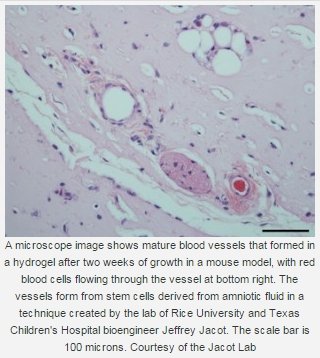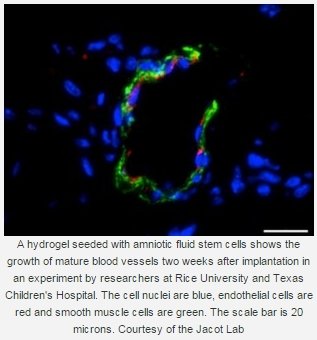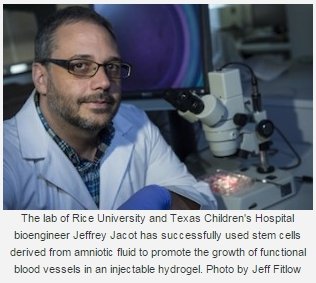In new experiments, the lab of bioengineer Jeffrey Jacot combined versatile amniotic stem cells with injectable hydrogels used as scaffolds in regenerative medicine and proved they enhance the development of vessels needed to bring blood to new tissue and carry waste products away. The results appear in the Journal of Biomedical Materials Research Part A.

Jacot and his colleagues study the use of amniotic fluid cells from pregnant women to help heal infants born with congenital heart defects. Such fluids, drawn during standard tests, are generally discarded but show promise for implants made from a baby’s own genetically matched material.
He contends amniotic stem cells are valuable for their ability to differentiate into many other types of cells, including endothelial cells that form blood vessels.
«The main thing we’ve figured out is how to get a vascularized device:
— See more at: http://news.rice.edu/2015/04/08/amniotic-stem-cells-demonstrate-
He contends amniotic stem cells are valuable for their ability to differentiate into many other types of cells, including endothelial cells that form blood vessels.
«The main thing we’ve figured out is how to get a vascularized device:
— See more at: http://news.rice.edu/2015/04/08/amniotic-stem-cells-demonstrate-

In the lab, researchers from Rice, Texas Children’s Hospital and Baylor College of Medicine combined amniotic fluid stem cells with a hydrogel made from polyethylene glycol and fibrin. Fibrin is a biopolymer critical to blood clotting,
The lab used vascular endothelial growth factor to prompt stem cells to turn into endothelial cells, while the presence of fibrin encouraged the infiltration of native vasculature from neighboring tissue.
Mice injected with
Similar experiments using hydrogel seeded with bone
— See more at: http://news.rice.edu/2015/04/08/amniotic-stem-cells-demonstrate-

The lab will continue to study the use of amniotic cells to build biocompatible patches for the hearts of infants born with birth defects and for other procedures, Jacot said.
Rice alumnus Omar Benavides, now a senior product development engineer at Procyrion, is lead author of the paper.
Jacot is an associate professor of bioengineering at Rice, director of the Pediatric Cardiac Bioengineering Laboratory at the Congenital Heart Surgery Service at Texas Children’s and an adjunct assistant professor at Baylor College of Medicine.
The National Institutes of Health and the National Science Foundation supported the research.
— See more at: http://news.rice.edu/2015/04/08/amniotic-stem-cells-demonstrate-
Mike Williams
http://news.rice.edu


